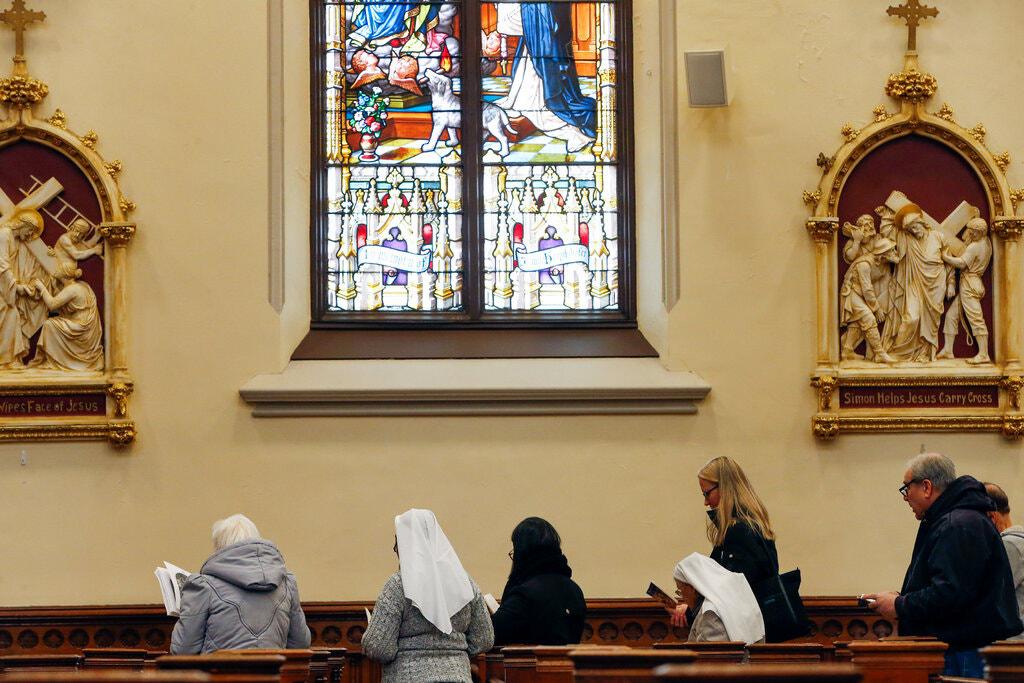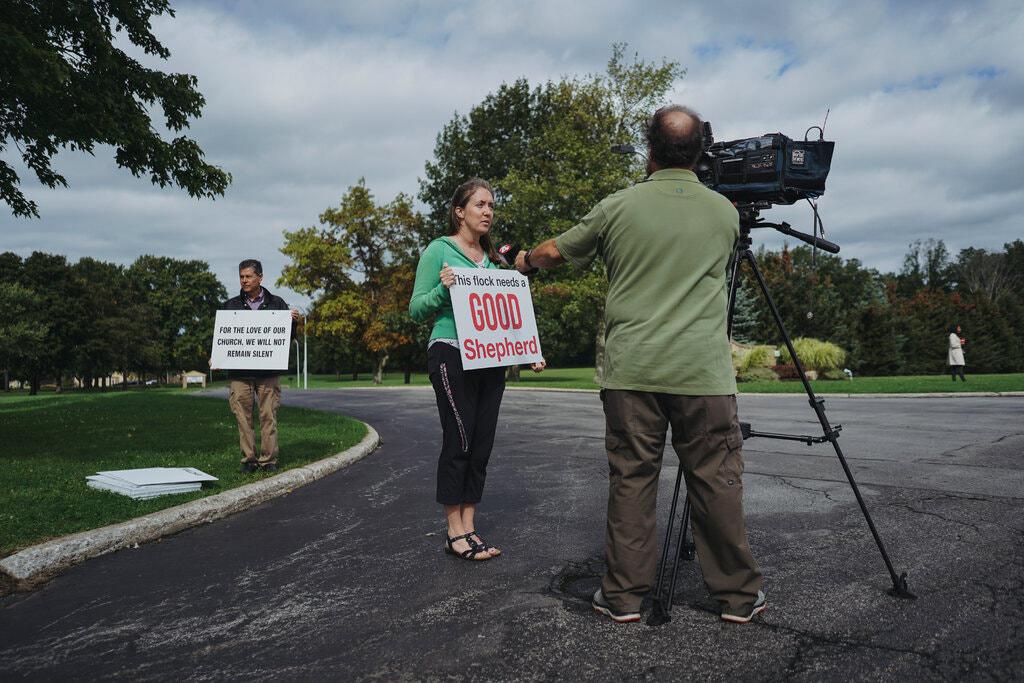|
Buffalo Diocese Accused of Yearslong Cover-Up of Sexual Abuse
By Liam Stack
The state Attorney General said in a lawsuit that two former top leaders helped shelter more than two dozen priests accused of harming children. The New York attorney general, Letitia James, on Monday accused the Roman Catholic Diocese of Buffalo and three bishops connected to it of engaging in a yearslong cover-up of sexual abuse by priests in violation of church policy and state law. The lawsuit is the first state legal action against the Catholic Church in New York since a new wave of abuse investigations began in 2018, and it is the culmination of just one of eight inquiries, one for each Catholic diocese in the state. The other seven inquiries are ongoing and could yield further lawsuits. The lawsuit represents what prosecutors believe is a novel legal strategy: The state will attempt to use civil laws, in particular those governing religious charities and their fiduciaries, to sue a Catholic diocese for failing to follow church policies enacted in 2002, after a series of investigative reports by The Boston Globe thrust the sex abuse scandal into public view. It also may also raise questions about religious liberty: In addition to restitution and changes in the way the diocese handles sexual abuse claims, the lawsuit seeks to ban two bishops from management roles in any charitable organization — a demand that may draw pushback from those who believe this encroaches into church autonomy. The attorney general said its investigation found that the diocese and its two former top leaders, Bishop Richard J. Malone and Auxiliary Bishop Edward M. Grosz, used bureaucratic maneuvers to shelter more than two dozen priests accused of harming children. Ms. James said in a statement that the prosecution aimed to right both a breach of trust and “a crisis of faith.” “For years, the Diocese of Buffalo and its leadership failed to protect children from sexual abuse,” she said. “Instead, they chose to protect the very priests who were credibly accused of these atrocious acts. Individuals who are victims of abuse deserve to have their claims justly and timely investigated and determined, and the Buffalo Diocese refused to give them that chance.” Greg Tucker, a spokesman for the diocese, said it was reviewing the lawsuit and was committed to working with the civil authorities to investigate “alleged crimes and complaints.” “In the meantime, we wish to reiterate that there is zero tolerance for sexual abuse of a minor or of sexual harassment of an adult in the Diocese of Buffalo by any member of the clergy, employee or volunteer,” he said. “The diocese has put in place rigorous policies and protocols governing required behavior as well as a code of conduct which all clergy are expected to abide by.” The lawsuit was celebrated by advocates who have worked for years to seek accountability from the Catholic Church. “Today it is a great day, and it has been a long time coming,” said Judith Quinn, the leader of the Buffalo chapter of the Survivors Network of Those Abused by Priests. “Victims will finally have a voice,” said Ms. Quinn, who has worked with abuse survivors since 1994. “There can be no healing until your story is told." David Gibson, the director of the Center on Religion and Culture at Fordham University, said the lawsuit “represents a real sea change” in the way New York approaches clergy sex abuse. “Even as recently as 2003 the state showed great deference to Catholic leaders,” said Mr. Gibson. “They did not want to be seen as attacking the Catholic Church because that was politically dangerous. Now in 2020 it is considered a political plus to try to hold the bishops accountable.” The Buffalo diocese, which includes 600,000 Catholics, careened from crisis to crisis in recent years under the leadership of Bishop Malone, who held a senior position in the Diocese of Boston when its sex abuse crisis became public in 2002. He resigned from his position in Buffalo in December after a Vatican investigation into his mishandling of the abuse crisis there. The Buffalo diocese filed for bankruptcy protection in February, citing a deluge of lawsuits filed by people who said they were sexually abused by priests as children. Mr. Gibson said the legal approach used by the attorney general was by no means guaranteed to work, but the case may be an important step toward addressing the shortcomings of the church’s response to sex abuse. “This is an example of the state, a secular government, doing what the Catholic Church was not able to do or was unwilling to do, which is to hold the bishops accountable,” said Mr. Gibson. “Unfortunately, it is a moot point because both these bishops have retired, the diocese is in bankruptcy and this legal argument is not a slam dunk. But there is symbolic power here.” Prosecutors said on Monday that the cover-up was conducted by Bishops Malone and Grosz, who sheltered two dozen credibly accused priests by classifying them as “unassignable,” an administrative category that allowed them to retire or go on medical leave instead of being referred them to a Vatican investigation that might ban them from the priesthood. That maneuver kept the men within the diocesan fold and on its balance sheet. Prosecutors said that abrogation of church policy placed the diocese in violation of state law because it constituted a misuse of charitable assets and a breach of fiduciary duty. Bishop Grosz retired in May after 30 years as an auxiliary bishop in the diocese, including 27 as one of the point men in its response to sexual abuse claims. After the departure of Bishop Malone, Pope Francis appointed Bishop Edward B. Scharfenberger of Albany to a caretaker role in Buffalo. Prosecutors said he was named in the suit in his capacity as the current administrator of the diocese. The procedures adopted by the United States Conference of Catholic Bishops in 2002, which the lawsuit notes both Bishop Malone and Bishop Grosz voted for, mandate that abuse accusations against priests be reported to the authorities in compliance with local law. But the impact in New York was limited because mandatory reporting laws in the state do not apply to priests. In Buffalo, the diocese reached a memorandum of understanding with local prosecutors in 2003 that obliged it to report abuse claims in the wake of The Boston Globe reports, but the agreement had severe shortcomings. Under the agreement, the diocese was only required to report allegations made within five years of the abuse, or within five years of the accuser’s 18th birthday. That vastly limited the number of referrals it was required to make. The lawsuit filed on Monday instead hinges on the provisions of the 2002 policies, commonly called the Dallas Charter, which require that abusers be removed from active ministry and have their cases referred to the Vatican, which can decide to remove them from the priesthood. Bishops accused of abuse were exempt from these policies, a loophole that was addressed by the creation of a separate oversight system in 2019. New York is one of several states that have redoubled efforts to seek justice for the survivors of clergy sex abuse in the wake of a bombshell report released by the State of Pennsylvania in 2018 that found that Catholic priests abused more than 1,000 children in six of the state’s eight dioceses over the course of 70 years. Months after the report was released, New York lawmakers passed the Child Victims Act, which had languished for 13 years as the church and other groups spent millions of dollars fighting it. The law extended the statute of limitations for childhood sex abuse, allowing victims to file lawsuits against their abusers until age 55 and allowing criminal prosecutions until a victim turned 28. The act also created a one-year “look back window” that allowed claims that had already exceeded the previous statute of limitations to be revived. Hundreds of lawsuits were filed against the Catholic Church in the days after the act was approved. Since then, three dioceses in addition to Buffalo have declared bankruptcy: Rochester, Syracuse and Rockville Centre on Long Island. In August, Gov. Andrew M. Cuomo extended the look back window until August 2021 to make up for the upheaval caused by the coronavirus pandemic. “We cannot let this pandemic limit the ability for survivors to have their day in court,” the governor said in a statement at the time.
|
.
Any original material on these pages is copyright © BishopAccountability.org 2004. Reproduce freely with attribution.

